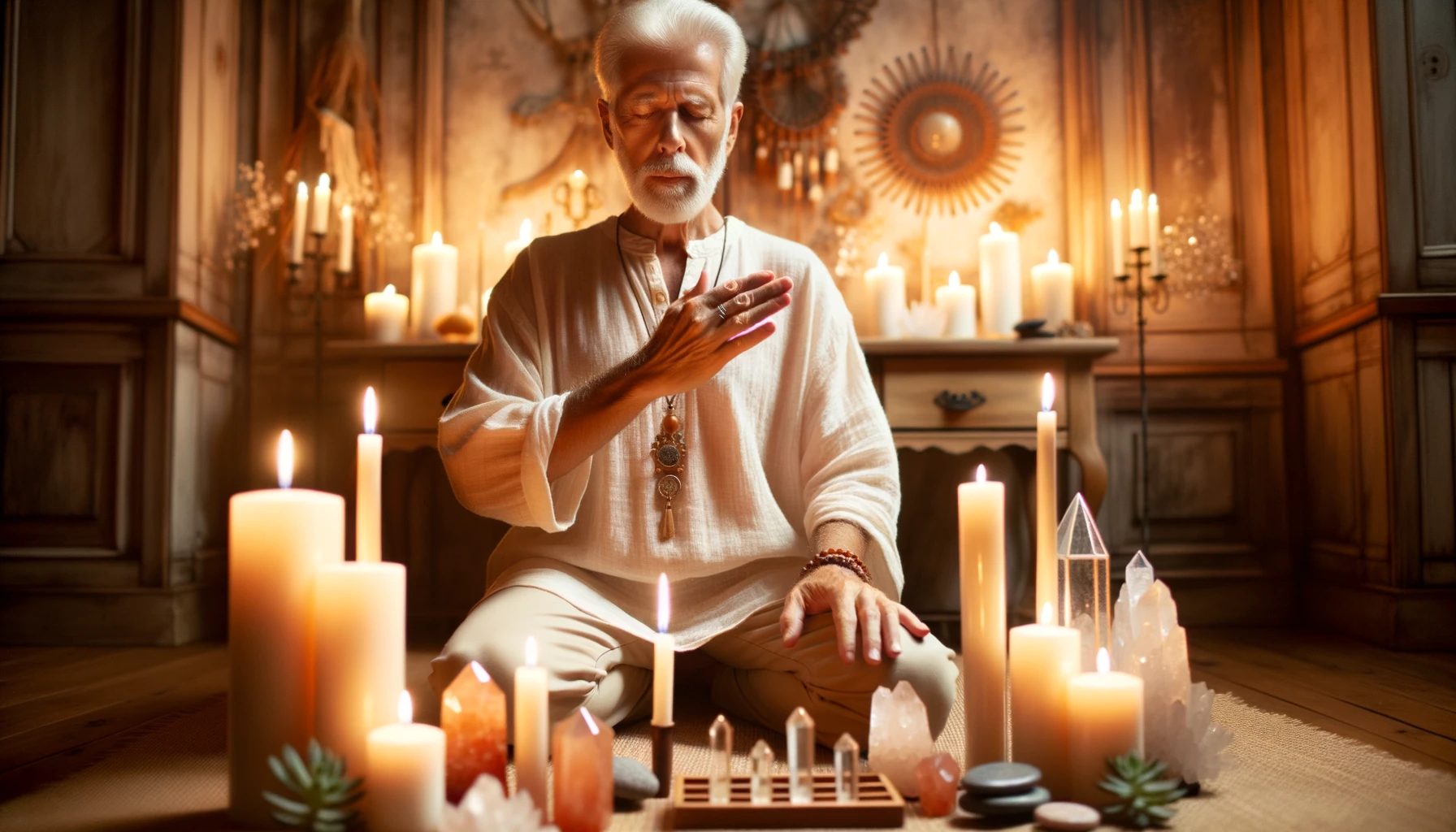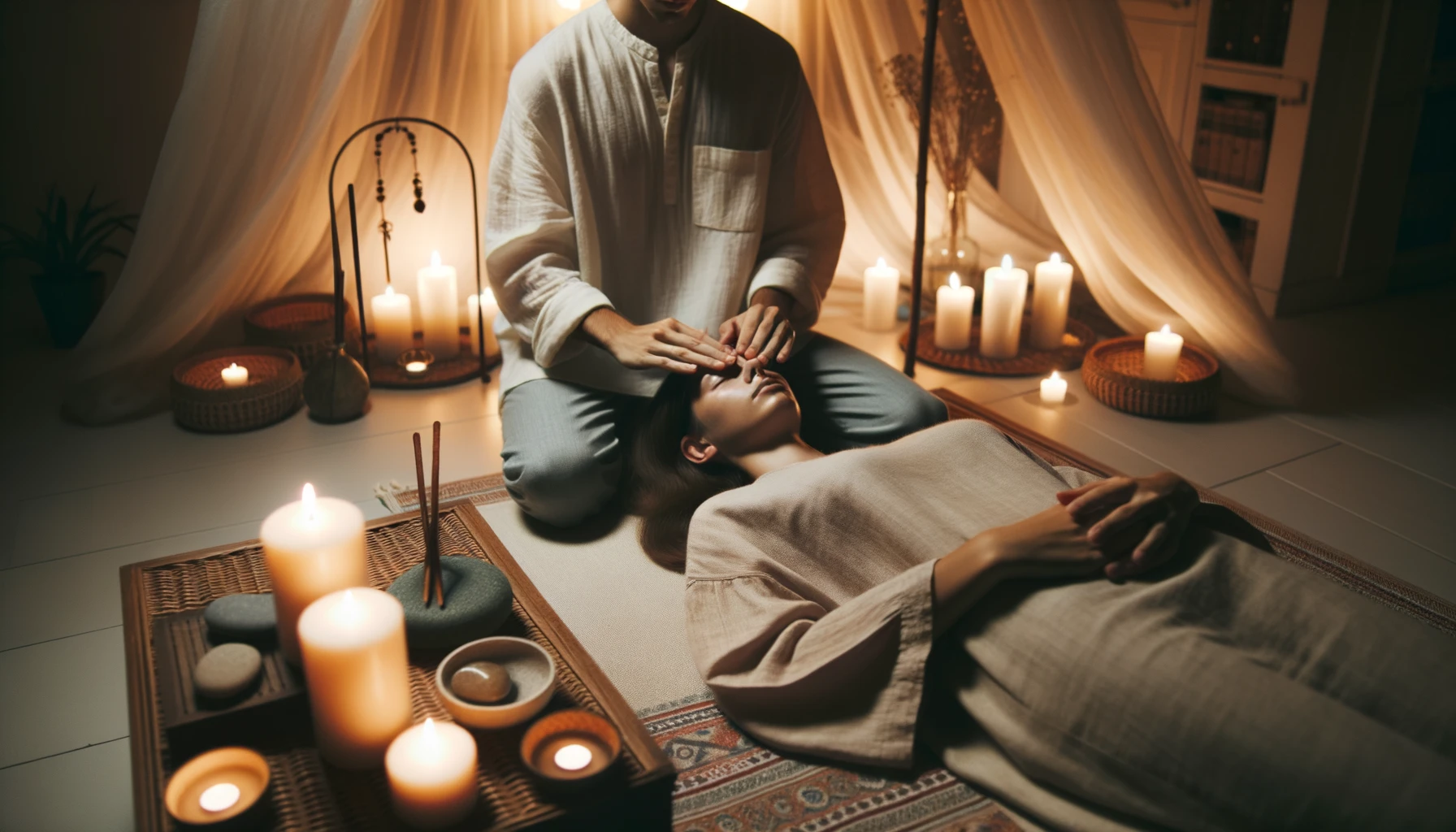
Are you ready to dive into the world of healing and discover the power of Reiki techniques? In this section, we will explore the importance of mastering the core Reiki techniques for enhancing skills in administering Reiki. By delving into the world of energy healing, spirituality, and holistic healing, practitioners can experience tranquility and well-being like never before.
Key Takeaways:
- Mastering core Reiki techniques is essential for improving skills in administering Reiki.
- Gasshō, the joining of hands in a prayerful state, forms the foundation of most Japanese Reiki techniques.
- Gasshō stills the mind, alleviates stress, and centers the whole being.
- Becoming a Reiki Master involves receiving the Master’s attunement, understanding how to give attunements, and teaching Reiki classes.
- Teaching Reiki allows practitioners to witness the power and benefits of Reiki in others’ lives.
Understanding the Three Pillars of Reiki
Let’s explore the three pillars of Reiki and how they contribute to overall well-being. The practice of Reiki encompasses various techniques that work together to improve oneself and promote balance, focus, and stress relief. Among these techniques, gasshō, reiji hō, and chiryō form the foundation of most Japanese Reiki practices, enhancing the experience of tranquility and holistic healing.
Gasshō, the first pillar, involves the joining of hands in a prayerful state. This simple yet powerful technique stills the mind, alleviates stress, and centers the whole being. It helps cultivate balance and focus, making it an essential practice for anyone seeking to enhance their Reiki skills. It is recommended to practice gasshō twice a day, dedicating a few moments to connect with the energy within and around us.
| Pillar | Technique | Benefits |
|---|---|---|
| Gasshō | Joining of hands | Redefines focus and balance |
| In prayerful state | Alleviates stress and stills the mind | |
| Reiji Hō | Using the Reiki symbols | Enhances intuition and connection with Reiki energy |
| Chiryō | Hands-on healing | Supports physical, emotional, and spiritual healing |
The second pillar of Reiki is reiji hō, which involves the use of Reiki symbols to enhance intuition and connect with the energy of Reiki. These symbols serve as powerful tools for focusing intention and channeling healing energy. Through the practice of reiji hō, practitioners can deepen their connection and understanding of Reiki, expanding their abilities to facilitate healing.
Finally, the third pillar is chiryō, which entails hands-on healing. This technique involves the gentle placement of hands on specific areas of the body to support physical, emotional, and spiritual healing. By applying Reiki energy through touch, practitioners can help restore balance and promote well-being in themselves and others.
“Reiki is the gift that keeps on giving. It allows us to tap into the limitless source of healing and light within ourselves.”
By mastering the three pillars of Reiki – gasshō, reiji hō, and chiryō – practitioners can unlock their full potential as Reiki healers. These techniques not only improve skills in administering Reiki but also contribute to overall well-being, providing a pathway to tranquility, spirituality, and holistic healing. Let us embrace and cultivate the power of Reiki in our lives, experiencing the profound effects of energy balancing, chakra healing, and stress reduction.
Becoming a Reiki Master
Embark on the journey of becoming a Reiki Master and discover the transformative power of self-healing and alternative medicine. As you delve deeper into the world of Reiki, you will unlock the ability to enhance your own well-being and share the healing energy with others.
Receiving the Master’s attunement is a pivotal step in the journey. This attunement opens up new channels of healing energy within you, allowing you to connect more deeply with the universal life force. It is a profound experience that strengthens your connection to Reiki and heightens your healing abilities.
Understanding how to give attunements is another crucial aspect of becoming a Reiki Master. Attunements are sacred rituals that enable others to access the healing power of Reiki. Through attunements, you can empower individuals to become Reiki practitioners themselves, spreading the positive impact of Reiki in their own communities.
Teaching Reiki classes is a significant role that comes with becoming a Reiki Master. It is a fulfilling endeavor that allows you to witness the transformative effects of Reiki in the lives of your students. By sharing your knowledge and experiences, you can guide and support others on their own healing journeys.
Mindfulness: A Path to Self-Discovery
In the pursuit of becoming a Reiki Master, mindfulness plays a crucial role. Mindfulness is being fully present in the moment, without judgment or attachment. It cultivates a deep sense of awareness and allows you to connect with your true essence.
By embracing mindfulness, you can tap into your intuition and make important life decisions with clarity and confidence. It helps you align with your spiritual path and discover your true purpose. Through mindfulness, you can experience inner peace, happiness, and a profound sense of connection to the world around you.
| Benefits of Becoming a Reiki Master |
|---|
| Enhanced self-healing journey |
| Opportunity to share the power of Reiki as an alternative medicine practice |
| Ability to guide and support others in their healing process |
| Deepening connection to spirituality and personal growth |
“Becoming a Reiki Master is not only about gaining knowledge and skills; it is a transformative journey of self-discovery and connection.” – Anonymous
Embarking on the path to becoming a Reiki Master is a rewarding and enlightening experience. As you master the core Reiki techniques, understand the three pillars of Reiki, and immerse yourself in the practice, you will unlock the true potential of healing, mindfulness, and spirituality.
Open yourself to the guidance of Reiki, surrender to its transformative power, and embrace the path of becoming a Reiki Master. Discover the profound impact it can have on your life and the lives of those around you. May your journey be filled with harmony, happiness, and peace.
Guiding Others with Reiki
Discover the joy of guiding others on their Reiki journey while experiencing personal growth and stress reduction. As a Reiki Master, teaching Reiki allows us to witness the power and benefits of Reiki in the lives of our students. It is a fulfilling experience that deepens our own understanding of this holistic healing practice.
When teaching Reiki, it is important to approach our students respectfully and create a safe and nurturing environment for their growth. By encouraging their own power and freedom of choice, we empower them to take ownership of their healing journey. Remember, each individual is unique, and their Reiki experience will be personal and transformative in its own way.
As authentic representatives of Reiki Energy, we must also set a good example for our students. Being mindful of our own self-care and practicing Reiki regularly helps us maintain balance and reduces stress in our own lives. By embodying the principles of Reiki, we become living examples of the healing power that our students aspire to achieve.
| Key Points: |
|
|---|
Quotes:
“Teaching Reiki is a journey of collaboration, growth, and transformation. It is a privilege to guide others on their path towards healing and self-discovery.” – Reiki Master
By guiding others with Reiki, we not only contribute to the well-being of our students but also deepen our own connection to this spiritual practice. Through the act of teaching, we further master the core techniques of Reiki and enhance our ability to share this profound healing modality with the world.
Surrendering to Reiki’s Guidance
Surrender to the guiding energy of Reiki and unlock a life filled with mindfulness, spirituality, happiness, and peace.
When we embrace the power of Reiki, we invite a profound shift in our lives. Through the practice of Reiki, we learn to surrender to its guidance, allowing it to lead us on a journey of self-discovery and transformation. Mindfulness becomes our compass, guiding us to be fully present in each moment, attuned to the subtle energies that surround us. As we deepen our connection with Reiki, we tap into a wellspring of spirituality that nourishes our souls.
By surrendering to Reiki’s guidance, we open ourselves up to a world of happiness and peace. Reiki helps us to release negative energy and emotions, creating space for joy and contentment to enter our lives. It teaches us to let go of attachments and fears, allowing us to experience a sense of freedom and liberation. Our hearts become lighter, and our spirits soar as we align with the universal flow of energy.
Reiki is not just a healing modality; it is a way of life. Through Reiki, we learn to trust our intuition and follow our true spiritual path. It becomes our constant companion, supporting us in making important life decisions. As we surrender to Reiki’s guidance, we find ourselves in harmony with the universe, experiencing a deep sense of purpose and fulfillment.
Surrendering to Reiki’s guidance is a beautiful journey of self-discovery and growth. It invites us to embrace the power of mindfulness, spirituality, happiness, and peace. As we immerse ourselves in the loving energy of Reiki, we discover that we are not alone on this path. Reiki becomes our guide, leading us towards a life filled with profound meaning and profound joy.
FAQ
What are the core Reiki techniques?
The core Reiki techniques include gasshō, reiji hō, and chiryō. These techniques work together to enhance skills in administering Reiki.
What is gasshō?
Gasshō is the joining of hands in a prayerful state, which forms the foundation of most Japanese Reiki techniques. It promotes balance, focus, and stress relief.
How often should I practice gasshō?
It is recommended to practice gasshō twice a day to cultivate balance and focus.
What does it take to become a Reiki Master?
Becoming a Reiki Master involves receiving the Master attunement, understanding how to give attunements, and teaching Reiki classes. It is a journey of self-healing, alternative medicine, and mindfulness.
What is the role of a Reiki Master in guiding others?
As a Reiki Master, you have the opportunity to guide others by teaching Reiki. It is important to treat students with respect, encourage their own power and freedom of choice, and set a good example as an authentic representative of Reiki energy. Reiki can aid in stress reduction for both practitioners and their students.
How can Reiki help in making life decisions?
Reiki can guide practitioners in making important life decisions and following their true spiritual path. Surrendering to Reiki’s guidance brings harmony, happiness, and peace. Mindfulness, spirituality, and a deep connection to Reiki are integral to this transformative process.



